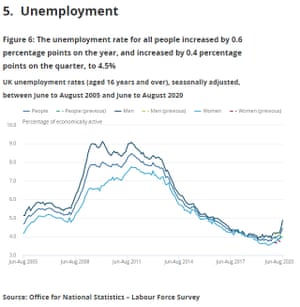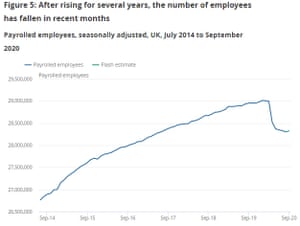Unemployment in the UK is rising at the fastest pace since the aftermath of the financial crisis, as the Covid-19 pandemic continues to hurt the economy, costing more people their jobs.
The latest labor force statistics, just released, show that Britain’s unemployment rate jumped to 4.5% in the June-August period.
That’s a sharp jump on the 4.1% recorded a month ago and looks to be the highest level since spring 2017.
According to the Office for National Statistics, there were an estimated 1.52 million people unemployed in the June-August quarter. That’s an increase of 209,000 in the year and up 138,000 in the quarter.
The ONS explains:
The annual increase was the largest since September to November 2011 and the quarterly increase was the largest since May to July 2009.
It adds:
- the estimated UK unemployment rate for men was 4.9%; this is 0.8 percentage points higher than a year earlier and 0.7 percentage points higher than the previous quarter
- the estimated UK unemployment rate for women was 4.0%; this is 0.3 percentage points higher than a year earlier and 0.1 percentage points higher than the previous quarter
This increase shows that after months of lockdown restrictions, some firms were forced to let staff go over the summer - or collapsed altogether.
Worryingly, this comes before the government winds up the furlough scheme. August, you may remember, was the Eat Out To Help Out month, when the government-subsidized meals in pubs, restaurants, and cafes to prop up the economy.
The ONS also reports that the Claimant Count, which measures the number of people receiving jobless support, has surged by 120.3% since March 2020.
The employment rate has fallen, down 0.3 percentage points in the quarter, to 75.6%. And redundancies increased by a record 114,000 on the quarter.
The Office of National Statistics also estimates that the slump in UK payrolls may have stopped last month, after heavy falls earlier in the pandemic.
It says:
Early estimates for September 2020 suggest that there is little change in the number of payroll employees in the UK; up 20,000 compared with August 2020.
Since March 2020, the number of payroll employees has fallen by 673,000; however, the larger falls were seen at the start of the coronavirus (COVID-19) pandemic.
But... struggling companies could still furlough workers in September, and get the government to cover some of their wages.
The number of people made redundant from their job in the UK jumped at a record rate over the summer, driving the unemployment rate up.
The ONS says:
Redundancies increased by 113,000 on the year, and a record 114,000 on the quarter, to 227,000.
The annual increase was the largest since April to June 2009, with the number of redundancies reaching its highest level since May to July 2009.
On employment, it shows that the number of people in work fell by over 150,000 in the last quarter, to below 32.6 million. This pulled the employment rate down from 75.9% to 75.6%.
The ONS says younger workers, part-time staff, and self-employed people were the worst hit.
Estimates for June to August 2020 show 32.59 million people aged 16 years and over in employment, 102,000 fewer than a year earlier. This annual decrease was driven by men in employment (down by 213,000 on the year to 17.04 million).
Employment decreased by 153,000 on the quarter; men in employment decreased by 115,000, while women in employment decreased by 38,000. This quarterly decrease was driven by people in employment aged 16 to 24 years, the self-employed and part-time workers, but was partly offset by increases in employment for people aged 25 to 64 years and full-time employees.





